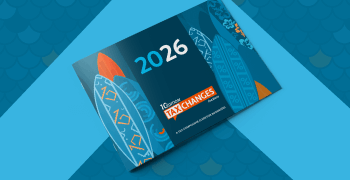Debunking 4 myths about voluntary disclosure agreements
Understanding all aspects of sales tax compliance can be tricky, and occasionally, despite the best intentions, mistakes are made. At Avalara, we know our customers sometimes realize they should have been collecting and remitting taxes in jurisdictions where they haven’t been. When that happens, they may wonder, “Now what do I do?”
There’s no need to panic if you find yourself in this predicament. However, it’s important to understand your options and have a plan to remedy the situation.
Participation in a voluntary disclosure agreement (VDA) may be something you should consider if you haven’t registered to collect in a state where you should have. But is a VDA right for you? Through conversations with our customers, we know there are many questions when it comes to VDAs. To help answer some of the questions and help you decide if a VDA is right for you, read on to see four common misconceptions about VDAs debunked.
What is a Voluntary Disclosure Agreement (VDA)?
A VDA is a binding agreement between a taxpayer and a state that’s designed to encourage compliance with the state’s tax laws. Generally, VDAs reduce or waive penalties, limit the look-back period (the length of time a state can hold a taxpayer liable for unpaid tax), and provide some audit protection for taxpayers who proactively disclose prior tax obligations, pay what they owe, and comply with state tax laws moving forward.
Most states offer VDAs for sales tax, though not all have written guidelines for them, and VDA programs can vary widely from state to state. For example, while a VDA will limit the look-back period to three or four years in many states, the maximum look-back period of the Iowa VDA is typically five years; California’s VDA look-back period is three years; Nevada has an eight-year look-back period; and Hawaii’s VDA look-back period is 10 years.
Now that we’ve reviewed what a VDA is, let’s look at four common VDA myths.
Common VDA myths debunked
Myth 1: If I wait, the problem will go away.
You’re required to collect and remit sales tax in states where you have nexus, a substantial connection. Nexus is established when you have a physical presence in a state, such as a store or office. In some states, nexus is triggered by storing inventory for sale in the state (even in a third-party-owned warehouse), by making deliveries into the state, or by sending employees or independent contractors to the state.
To increase tax collections from out-of-state sellers, states are increasingly basing nexus on other connections. Some (e.g., Massachusetts and Ohio) now hold that putting software apps or web cookies on a customer’s computer, laptop, or mobile device triggers nexus. Others, like South Dakota and Tennessee, hold that nexus is triggered when an out-of-state business has a certain amount of economic activity in the state. While some nexus-expanding laws are on hold pending litigation, some are being enforced.
Furthermore, some states are asking large marketplace facilitators like Amazon to disclose the identities of their third-party sellers. Amazon has complied with this sort of request in Massachusetts and Rhode Island. The Massachusetts Department of Revenue says it will use this information to identify sellers who have inventory, make sales, and should be collecting and remitting in Massachusetts. And since Rhode Island and Massachusetts will likely share their lists of Fulfillment by Amazon (FBA) sellers, other states may soon be able to do the same.
In other words, waiting will not make this problem go away. If anything, it could make it worse. With states looking to increase remote sales tax collections, you’re unlikely to stay off their radar forever.
Myth 2: I can just sign a VDA as soon as I hear from a state.
While VDAs differ from state to state, most are not open to taxpayers who’ve been contacted by the state over the taxes in question. For example:
- The Texas Comptroller explains, “[Voluntary disclosure agreements] will be offered to taxpayers who have not been contacted regarding an audit or investigation, either verbally or in writing.”
- Maine Revenue Services writes, “You must not have been contacted by Maine Revenue Services concerning your tax status, any tax liability, or any tax audit with respect to any tax type(s) disclosed on the application.”
VDAs reward voluntary compliance. If you wait until a state “catches” you to come forward, you aren’t really coming forward voluntarily, so the same benefits don’t apply.
The consequences of being contacted first by the state would be no limited look-back period protection, no penalty waiver, and possible criminal or civil actions against the owners/officers of the company.
Myth 3: VDAs won’t reduce my liability that much, compared to an audit.
Participation in a voluntary disclosure program won’t free you from all past tax liability. However, it will likely reduce your overall tax liability.
For example, Florida generally waives all penalties for successful participants, “unless tax has been collected and not remitted.” It will limit the look-back period to three years, while “failure to take advantage of this program could result in the Department holding the taxpayer liable for the applicable (longer) limitation periods of the relevant taxes.”
New Jersey limits the look-back period to four years. If you’re discovered under audit or as part of a nexus investigation, you could be subject to unlimited look-back years.
The late filing penalty in New Jersey is 5 percent of the tax due for each month a return is late, to a maximum of 25 percent. An additional $100 penalty may be charged for each month the return is late. Interest is calculated at 3 percent above the prime rate. For successful participants of the VDA, the state will only assess statutory interest, and it generally waives some or all penalties.
Every VDA is unique, and the costs of non-compliance vary by jurisdiction. The perk of VDAs is that they generally limit your liability.
Myth 4: A VDA will take a lot of time and effort on my end to complete.
Companies considering a voluntary disclosure program have options. You can complete and submit the application yourself or work with a professional, who can help you navigate the process and prepare a VDA. Most applications are 2–3 pages long and require an explanation of the applicant’s type of business, activity in the state, and reason(s) for applying.
After an application has been submitted, taxpayers simply have to wait for the state(s) to respond. In our experience, the average time from start to completion of a VDA is approximately 4 to 6 months.
You won’t be accepted into a voluntary disclosure program without putting in some effort. However, the more you lean on outside resources, the less you have to do yourself.
Don't wait for a sales tax audit - investigate now
If you’re worried your business may not be sales tax compliant in one or more states, now may be the right time to talk with a trusted tax advisor about where you think you have nexus and whether a VDA is recommended.
If you’re a current Avalara customer, contact your account manager to learn about Avalara Professional Services and how we can help.
Although we hope you’ll find the information helpful, this does not offer a substitute for professional legal or tax advice. If you have questions about your tax liability or concerns about compliance, please consult your qualified legal, tax, or accounting professional.

Avalara Tax Changes 2026 is here
The 10th edition of our annual report engagingly breaks down key policies related to sales tax, tariffs, and VAT.
Stay up to date
Sign up for our free newsletter and stay up to date with the latest tax news.














